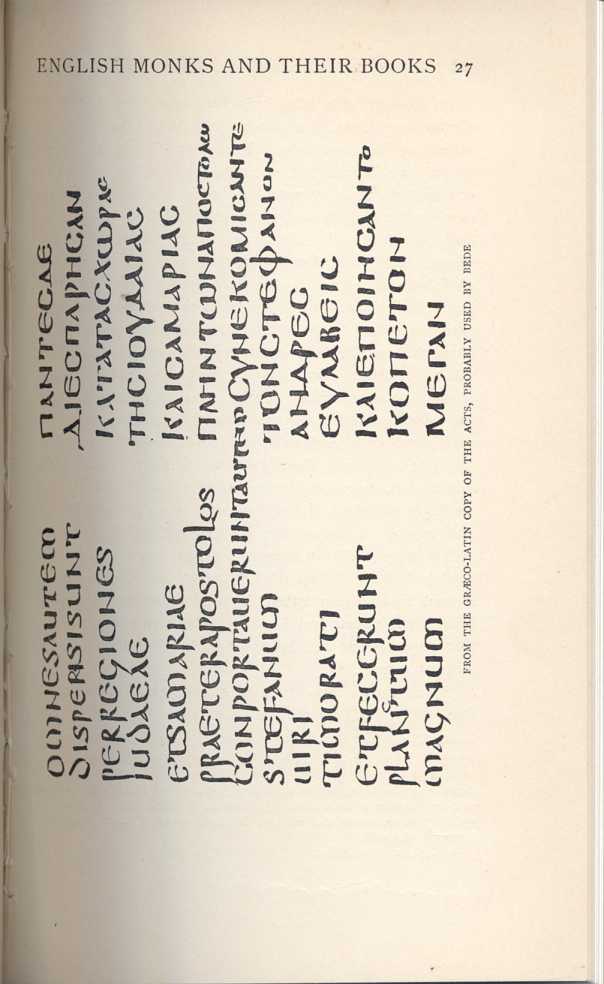| CHAPTER II: THE ENGLISH MONKS AND THEIR BOOKS Old English libraries; the making, collection and use of books during the middle ages | ||
2. § II
From the first we hear of books in connexion with Canterbury. Gregory the Great gave to Augustine, either just before his English mission, or sent to him soon afterward, nine volumes, which were put in St. Augustine's monastery
No further hint of books occurs until Theodore became Archbishop more than seventy years later. Theodore, who had been educated both at Tarsus and Athens, where he became a good Greek and Latin scholar, well versed in secular and divine literature, began a school at Canterbury for the study of Greek, and provided it with some Greek books. None of these books has been traced with certainty. Some may have existed in Archbishop Parker's time. "The Rev. Father Matthew," says Lambarde, in his Perambulation of Kent, . . . "showed me, not long since, the Psalter of David, and sundry homilies in Greek, Homer also, and some other Greek authors, beautifully written on thick paper with the name of this Theodore prefixed in the front, to whose library he reasonably thought (being led thereto by show of great antiquity) that they sometime belonged." The manuscript of Homer, now in Corpus Christi Library, Cambridge, did not belong to Theodore, but to Prior Selling, of whom we shall hear later. But possibly the famous Graeco-Latin copy of the Acts, now in the Bodleian Library, belonged either to Theodore or to his companion, Hadrian.[2.6]
 [Description: FROM THE GRÆCO-LATIN COPY OF THE
ACTS, PROBABLY USED BY BEDE]
[Description: FROM THE GRÆCO-LATIN COPY OF THE
ACTS, PROBABLY USED BY BEDE]Theodore, with Hadrian's help, not only started the Canterbury School, but encouraged similar foundations in other English monasteries. In southern England, however, Canterbury remained the centre of learning, and many ecclesiastics were attracted to it in consequence. Bede amply proves its efficiency as a school. And forasmuch as both Theodore and Hadrian were "fully instructed both in sacred and in secular letters, they gathered a crowd of disciples, and rivers of wholesome knowledge daily flowed from them to water the hearts of their hearers; and, together with the books of Holy Scripture, they also taught them the metrical art, astronomy, and ecclesiastical arithmetic. A testimony whereof is, that there are still living at this day some of their scholars, who are as well versed in the Greek and Latin tongues as in their own, in which they were born."[2.7] Elsewhere he mentions some of these scholars by name. Albinus, already referred to as the first English abbot of St. Augustine's, "was so well instructed in literary studies, that he had no small knowledge of the Greek tongue, and knew the Latin as well as the English, which was his native language."[2.8] "A most learned man" was another disciple, Tobias, bishop of Rochester, who, besides having a great knowledge of letters, both ecclesiastical and general, learned the Greek and Latin tongues "to such perfection, that they were as well known and familiar to him as his native language." [2.9]
Canterbury's most notable scholar was Aldhelm, the first bishop of Sherborne. In him were united the learning of the Canterbury and the Irish monks, for he studied first under Maildulf, the Irish monk and scholar
Aldhelm at length became abbot of Malmesbury (c. 675), and under him it grew to much greater eminence, and attracted a large number of students. Here, in the solitude of the forest tract, he passed his time in singing merry ballads to win the ear of the people for his more serious words, playing the harp, in teaching, and in reading the considerable library he had at hand. Bede describes him as a man "of marvellous learning both in liberal and ecclesiastical studies." Judging by his writings he was in these respects in the forefront of his contemporaries, although his learning was heavy and pretentious. From them also it is perfectly evident he could make use not only of the Bible, but of lives of the saints, of Isidore, of the Recognitions of Clement, of the Acts of Sylvester, of writings by Sulpicius Severus, Athanasius, Gregory, Eusebius, and Jerome, as well as of Terence, Virgil, Horace, Juvenal, Persius, and Prosper, and some other authors.[2.11]
| CHAPTER II: THE ENGLISH MONKS AND THEIR BOOKS Old English libraries; the making, collection and use of books during the middle ages | ||